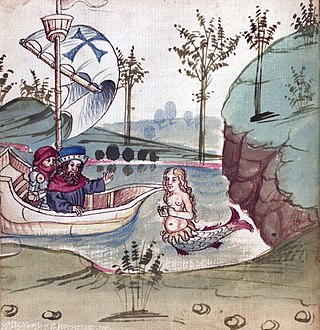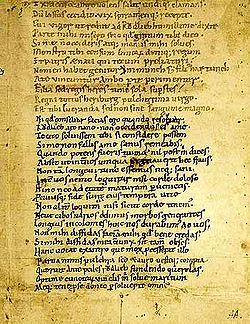
Mechthildof Magdeburg, a Beguine, was a Christian medieval mystic, whose book Das fließende Licht der Gottheit is a compendium of visions, prayers, dialogues and mystical accounts. She was the first mystic to write in Low German.

Landgrave was a rank of nobility used in the Holy Roman Empire, and its former territories. The German titles of Landgraf, Markgraf ("margrave"), and Pfalzgraf are of roughly equal rank, subordinate to Herzog ("duke"), and superior to the rank of a Graf ("count").

The Heliand is an epic alliterative verse poem in Old Saxon, written in the first half of the 9th century. The title means healer in Old Saxon, and the poem is a Biblical paraphrase that recounts the life of Jesus in the alliterative verse style of a Germanic epic. Heliand is the largest known work of written Old Saxon.

Karl Wilhelm Friedrich August Leopold Graf von Werder was a Prussian general.

The Annolied is an Early Middle High German poem in praise of Archbishop Anno II of Cologne. Anno died in 1075 and the poem, probably written in the years immediately after his death, can be seen as part of a campaign for his canonisation, which was finally achieved in 1183. The modern title is taken from the heading given to it by Martin Opitz in his edition of the text: RHYTHMVS DE S. ANNONE COLONIENSI ARCHIEPISCOPO.
In historical Germanic society, nīþ was a term for a social stigma implying the loss of honour and the status of a villain. A person affected with the stigma is a nīðing . Middle English retained a cognate nithe, meaning 'envy', 'hate', or 'malice'.

Ernst Gunther II, Duke of Schleswig-Holstein, was a son of Frederick VIII, Duke of Schleswig-Holstein and Princess Adelheid of Hohenlohe-Langenburg. He inherited his father's title as titular third duke of Schleswig-Holstein.
The Gesta Berengarii imperatoris is a Latin epic poem chronicling the career of Berengar of Friuli, King of Italy from 887 and Emperor from 915. It follows Berengar's career from its inception until his imperial coronation in Rome in December 915. It is a court panegyric and highly laudatory of its namesake.

Solomon and Marcolf is a medieval narrative describing the adventures and conversations of Solomon and Marcolf, or Marolf. The adventures have some connection with those of Ashmedai, while the conversations consist chiefly of riddles similar to those put to Solomon by the Queen of Sheba. The exact extent of its indebtedness to the Haggadah is somewhat doubtful, though it is practically certain that the various versions are derived from an Eastern original.

Gustav von Alvensleben was a Prussian General der Infanterie.

Codex Carolinus is an uncial manuscript of the New Testament on parchment, dated to the 6th or 7th century. It is a palimpsest containing a Latin text written over a Gothic one. The Gothic text is designated by siglum Car, the Latin text is designated by siglum gue or by 79, it represents the Old Latin translation of the New Testament. It is housed in the Herzog August Library in Wolfenbüttel in Lower Saxony, Germany.
The Jüngere Hochmeisterchronik, Croniken van der Duytscher Oirden, or Utrecht Chronicle of the Teutonic Order is a Middle Dutch chronicle of the Teutonic Order. It was written in or around the city of Utrecht in the Low Countries in several phases: around 1480, around 1491, and with some minor alterations after 1492. It has been referred to as “the final piece of the puzzle that is the official historiographic tradition of the Teutonic Order”. The anonymous chronicle was likely authored by the land commander of the Utrecht bailiwick of the Teutonic Order, Johan van Drongelen, in cooperation with his personal secretary Hendrik Gerardsz. van Vianen.

The Battle of Cassano was fought in the Autumn of 1259 between Guelph and Ghibelline armies in Northern Italy.
Middle High German literature refers to literature written in German between the middle of the 11th century and the middle of the 14th. In the second half of the 12th century, there was a sudden intensification of activity, leading to a 60-year "golden age" of medieval German literature referred to as the mittelhochdeutsche Blütezeit. This was the period of the blossoming of Minnesang, MHG lyric poetry, initially influenced by the French and Provençal tradition of courtly love song. The same sixty years saw the composition of the most important courtly romances. again drawing on French models such as Chrétien de Troyes, many of them relating Arthurian material. The third literary movement of these years was a new revamping of the heroic tradition, in which the ancient Germanic oral tradition can still be discerned, but tamed and Christianized and adapted for the court.
Old High German literature refers to literature written in Old High German, from the earliest texts in the 8th century to the middle of the 11th century.

The Asseburg is a ruined hill castle on the narrow, southern crest of the Asse ridge in the Harz Mountains of Germany, not far from Wolfenbüttel. The castle was built around 1218 by Gunzelin of Wolfenbüttel and his descendants of the House of Asseburg, as a so-called Ganerbenburg, or castle managed and occupied by more than one family or branch. Based on its dimensions, this elongated fortification was the largest hill castle in North Germany and was considered impregnable. Its purpose was to secure the lands around Wolfenbüttel.
Benjamin Sigmund Oehrl is a German archaeologist and philologist who specializes in Germanic studies.

Clara Steinitz was a German novelist, feuilletonist, and translator from English, French, Italian, and Norwegian.

Wilfried Rosendahl is a German bioarchaeologist, geoscientist, and cultural manager, general director of the Reiss-Engelhorn-Museums in Mannheim, and honorary professor at the Institute of History at the University of Mannheim.
The Armleder persecutions were a series of massacres against Jews in Franconia and Alsace in 1336–1339.













